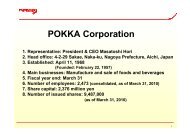Issue of Annual Report 2010
Issue of Annual Report 2010
Issue of Annual Report 2010
You also want an ePaper? Increase the reach of your titles
YUMPU automatically turns print PDFs into web optimized ePapers that Google loves.
Notes to Consolidated Financial Statements<br />
1. Basis <strong>of</strong> Presentation<br />
The Company and its domestic consolidated subsidiaries maintain their accounting records and prepare their financial statements in accordance<br />
with accounting principles generally accepted in Japan, which are different in certain respects as to the application and disclosure requirements<br />
<strong>of</strong> International Financial <strong>Report</strong>ing Standards, and its consolidated foreign subsidiaries, in conformity with that <strong>of</strong> their country <strong>of</strong> domicile. The<br />
accompanying financial statements have been compiled from the consolidated financial statements prepared by the Company as required by the<br />
Financial Instruments and Exchange Act <strong>of</strong> Japan.<br />
The relevant notes have been prepared as additional information. In addition, certain reclassifications have been made to present the<br />
accompanying consolidated financial statements in a format which is familiar to readers outside Japan. In addition, certain reclassifications <strong>of</strong><br />
previously reported amounts have been made to conform the consolidated financial statements for the years ended December 31, 2008 and<br />
2009 to the <strong>2010</strong> presentation.<br />
For the convenience <strong>of</strong> the reader, the accompanying consolidated financial statements as <strong>of</strong> and for the year ended December 31, <strong>2010</strong><br />
have been translated from yen amounts into U.S. dollar amounts at the rate <strong>of</strong> ¥81.44=U.S.$1.00, the exchange rate prevailing on December<br />
31, <strong>2010</strong>.<br />
2. Summary <strong>of</strong> Significant Accounting Policies<br />
(a) Principles <strong>of</strong> consolidation<br />
The accompanying consolidated financial statements include the accounts <strong>of</strong> the Company and its significant subsidiaries. All significant intercompany<br />
balances, transactions and pr<strong>of</strong>its have been eliminated in consolidation.<br />
During the year ended December 31, <strong>2010</strong>, the Company newly established 1 subsidiary, gained 2 subsidiaries via share acquisitions, lost 1<br />
subsidiary due to corporate liquidation, and lost 4 subsidiaries due to a merger among consolidated subsidiaries overseas. Accordingly, the<br />
number <strong>of</strong> consolidated subsidiaries was 33 as <strong>of</strong> December 31, <strong>2010</strong>.<br />
The Company’s remaining subsidiaries, whose gross assets, net sales, net income and retained earnings were not significant in the aggregate<br />
in relation to comparable balances in the consolidated financial statements, have not been consolidated.<br />
(b) Investments in unconsolidated subsidiaries and affiliates<br />
During the year ended December 31, <strong>2010</strong>, the Company lost 1 subsidiary due to corporate liquidation. As a result, the Company had made<br />
investments in 6 affiliates accounted for by the equity method as <strong>of</strong> December 31, <strong>2010</strong>.<br />
Investments in unconsolidated subsidiaries and affiliates other than those accounted for by the equity method are stated at cost determined<br />
by the moving-average method as, in the aggregate, they were not material.<br />
(c) Cash equivalents<br />
All highly liquid investments with a maturity <strong>of</strong> three months or less when purchased are considered cash equivalents.<br />
(d) Marketable and investment securities<br />
Securities other than those <strong>of</strong> subsidiaries and affiliates are classified into three categories: trading, held-to-maturity and other securities.<br />
Trading securities are carried at fair value and held-to-maturity securities are carried at amortized cost. Marketable securities classified as other<br />
securities are carried at fair value as <strong>of</strong> the end <strong>of</strong> the year, with any net unrealized gain or loss included as a separate component <strong>of</strong> shareholders’<br />
equity, net <strong>of</strong> the related taxes.<br />
Nonmarketable securities classified as other securities are carried at cost. Cost <strong>of</strong> securities sold is determined by the moving-average method.<br />
(e) Derivatives<br />
Derivatives positions are stated at fair value.<br />
(f) Inventories<br />
Inventories are stated at cost determined principally by the average method.<br />
(g) Property, plant and equipment<br />
Property, plant and equipment is stated at cost. Depreciation is computed by the declining-balance method over the estimated useful lives <strong>of</strong> the<br />
manufacturing facilities for alcoholic beverages and s<strong>of</strong>t drinks, and by the straight-line method for the real estate assets held and for buildings<br />
acquired in Japan subsequent to March 31, 1988. The annual provisions for depreciation have been computed over periods from 2 to 65 years<br />
for buildings and structures, and from 2 to 17 years for machinery and vehicles.<br />
For property and equipment retired or otherwise disposed <strong>of</strong>, costs and related depreciation are charged to the respective accounts and the<br />
net difference, less any amount realized on disposal, is charged to operations.<br />
SAPPORO HOLDINGS LIMITED<br />
<strong>Annual</strong> <strong>Report</strong> <strong>2010</strong><br />
37



